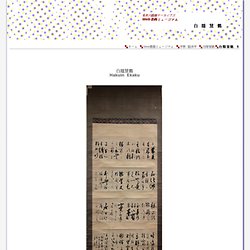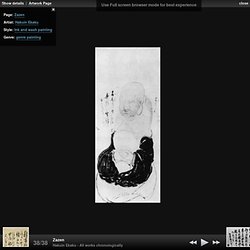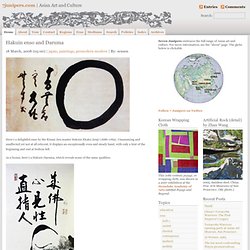Zoom
Trash

Chan Verse, Zen Poetry, Quotations, Sayings - #9. . Zen Poetry Selected Quotations The Zen legend of the beginning of the Zen transmission is that oncebefore an assembly Shakyamuni Buddha said nothing but held up a flowerand winked -- no one understood but the chief disciple Maha-Kasyapa, who smiled.

Buddha said, "I have the treasury of the eye of true teaching, the ineffable mind of nirvana, the true form, which is formless - this I hand on to Maha-Kasyapa. - Thomas Cleary, Shobogenzo: Zen Essays by Dogen, p. 75. A haiku is not a poem, it is not literature; it is a hand beconing, a door half-opened, a mirror wiped clean. It is a way of returningto nature, to our moon nature, our cherry blossom nature, our falling leaf nature, in short, to our Buddha nature.
The road enters green mountains near evening's dark; Beneath the white cherry trees, a Buddhist temple Whose priest doesn't know what regret for spring's passing means- Each stroke of his bell startles more blossoms into falling. - Keijo Shurin Flowers in the Sky Vegetable Nirvana. 白隠慧鶴 渡唐天神図/Web書画ミュージアム. 白隠慧鶴 尺牘/掛け軸 絵画の買取.販売.表装/長良川画廊. 作家名 白隠慧鶴 はくいん えかく 作品名 尺牘 作品詳細 掛け軸 紙本水墨 緞子裂 合箱 本紙(台紙)寸法59.3×125㎝ 全体寸法75.7×181.5㎝ 註釈.

True Mountain Covered with Cloud (Shin Un'zan) - Hakuin Ekaku. This artwork is in the public domain.

Why? The Existential Buddhist. The Place of Good Zen (Calligraphy by Zen Master Hakuin Ekaku, 1686-1768) Two years have passed since I first wrote about my intention to receive jukai, the Buddhist precepts, in a lay ordination ceremony.

In the intervening years I’ve been studying the precepts with a Zen priest, and sewing my rakusu, the ritual garment that signifies lay ordination. The ceremony takes place in another week after our regular zazenkai, or half-day sitting. It seems a fitting time to reflect back on the process and the meaning of the ceremony. Two years ago I wrote: Calligraphy: "The Shrine of the heaven illuminating great-august-god [centre]; Hachiman, the great Bodhisattva [right]; Kasuga, the great illuminating god [left]", (18th century) by HAKUIN Ekaku. The three inscriptions read: Centre: The Shrine of Heaven illuminating great-august-God Left: Kasuga, the great illuminating God Right: Hachiman, the great Bodhisattva.
![Calligraphy: "The Shrine of the heaven illuminating great-august-god [centre]; Hachiman, the great Bodhisattva [right]; Kasuga, the great illuminating god [left]", (18th century) by HAKUIN Ekaku](http://cdn.pearltrees.com/s/pic/th/calligraphy-illuminating-64544409)
Hakuin is revered as one of the great teachers of the Rinzai sect of Zen Buddhism and is particularly known for his bold and emphatic large characters which reveal great expressive power, reflecting the spontaneous and subjective aspirations that are at the heart of Zen philosophy. The harmony between the complementary ideologies of Buddhism and the native Shinto is perfectly illustrated in this calligraphy, with its synthesis of Buddhist and Shinto messages, written by a Buddhist monk. Art Gallery Handbook, 1999. pg. 279. Mamezo Hotei by Hakuin Ekaku. Virtue - Hakuin Ekaku. This artwork is in the public domain.

Why? Hakuin enso and Daruma. Here’s a delightful enso by the Rinzai Zen master Hakuin Ekaku Zenji (1686-1769).

Unassuming and unaffected yet not at all reticent, it displays an exceptionally even and steady hand, with only a hint of the beginning and end at bottom left. As a bonus, here’s a Hakuin Daruma, which reveals some of the same qualities. Hakuin Ekaku (1685-1768), Saigyo Hoshi. Conscience sans objet non dualisme. Si l'on me demande : "Qu'est le véritable esprit de méditation ?

", je répondrai qu'il consiste à maintenir un coeur bienveillant et compatissant, que l'on parle ou que l'on remue son coude en écrivant, que l'on soit en mouvement ou en repos, que la chance soit bonne ou mauvaise, que l'on soit dans l'honneur ou dans la honte, en gain ou en perte, dans le bien ou le mal, ramassant tous ces éléments en une seule strophe, dirigeant et concentrant son énergie avec la force d'un roc de fer sous le nombril et la partie inférieur de l'abdomen. (...) Alors, debout ou assis, en mouvement ou au repos, vérifiez de temps à autre si vous avez perdu ou non le juste état d'esprit. C'est le chemin correct de la véritable discipline des sages et des saints du temps passé et du temps présent. Le sage a dit à propos de cette méditation ininterrompue dans toutes les activités de l'existence (...) on doit comprendre que cette activité (méthode) porte sur l'état du Moi réel.